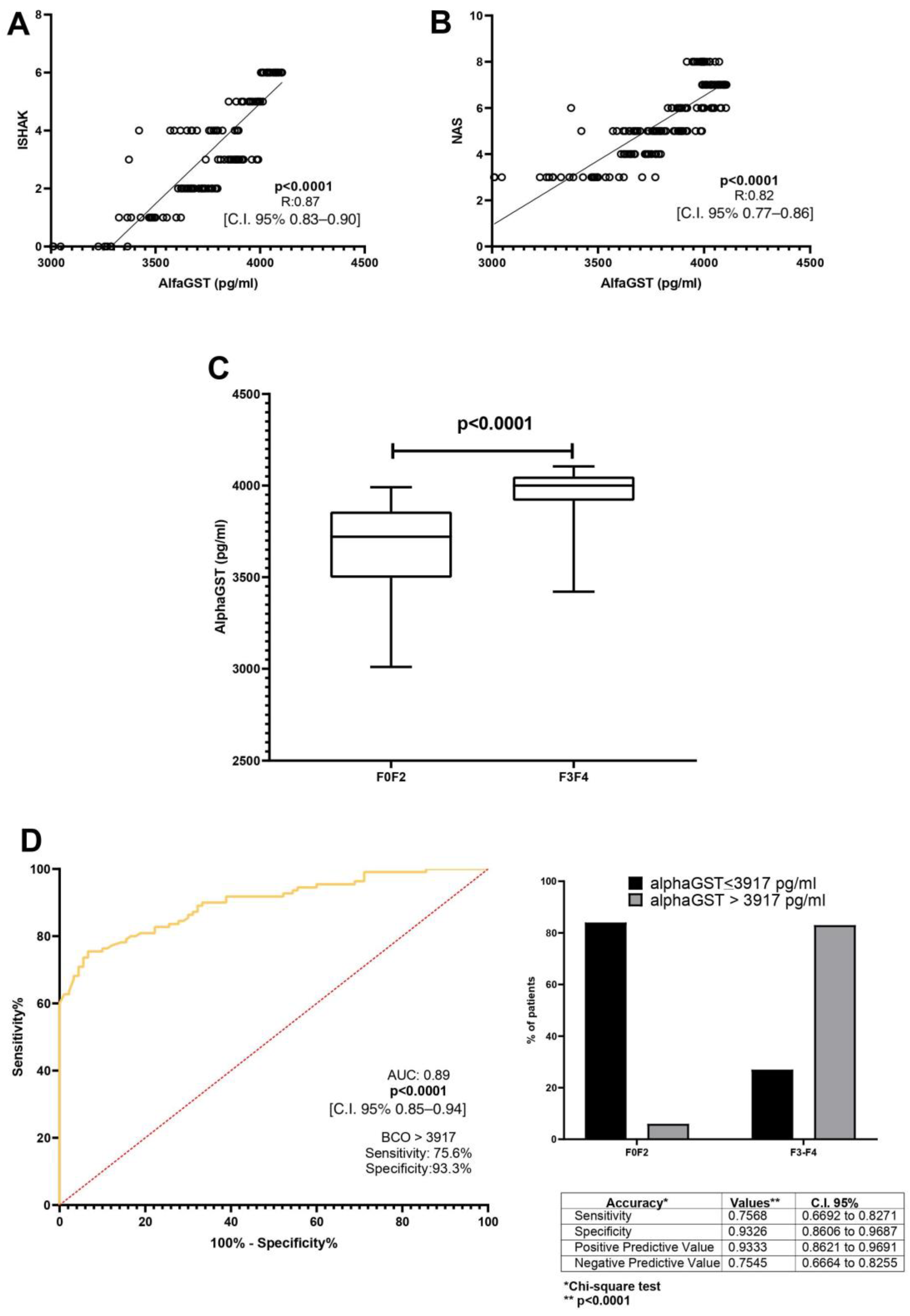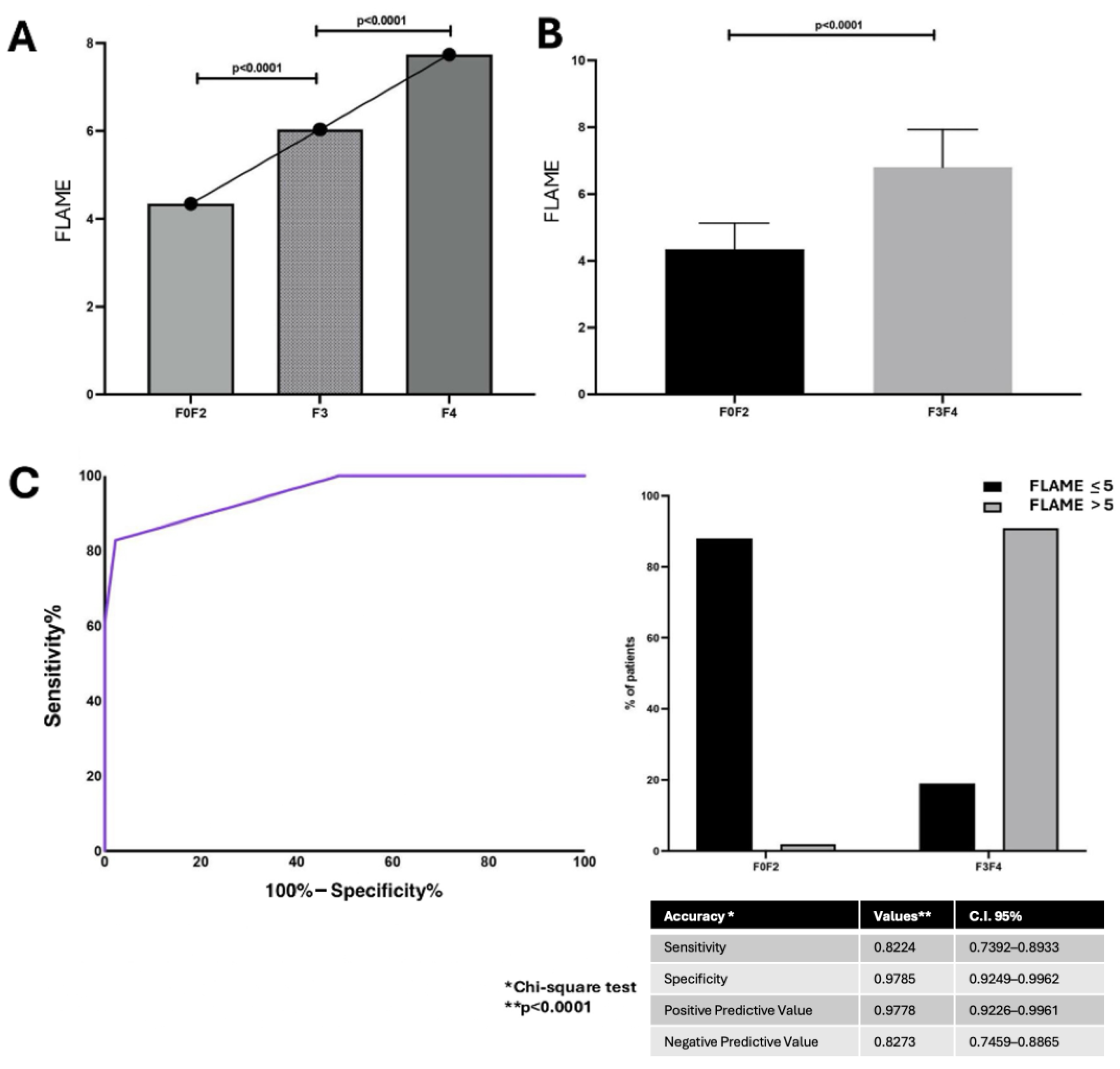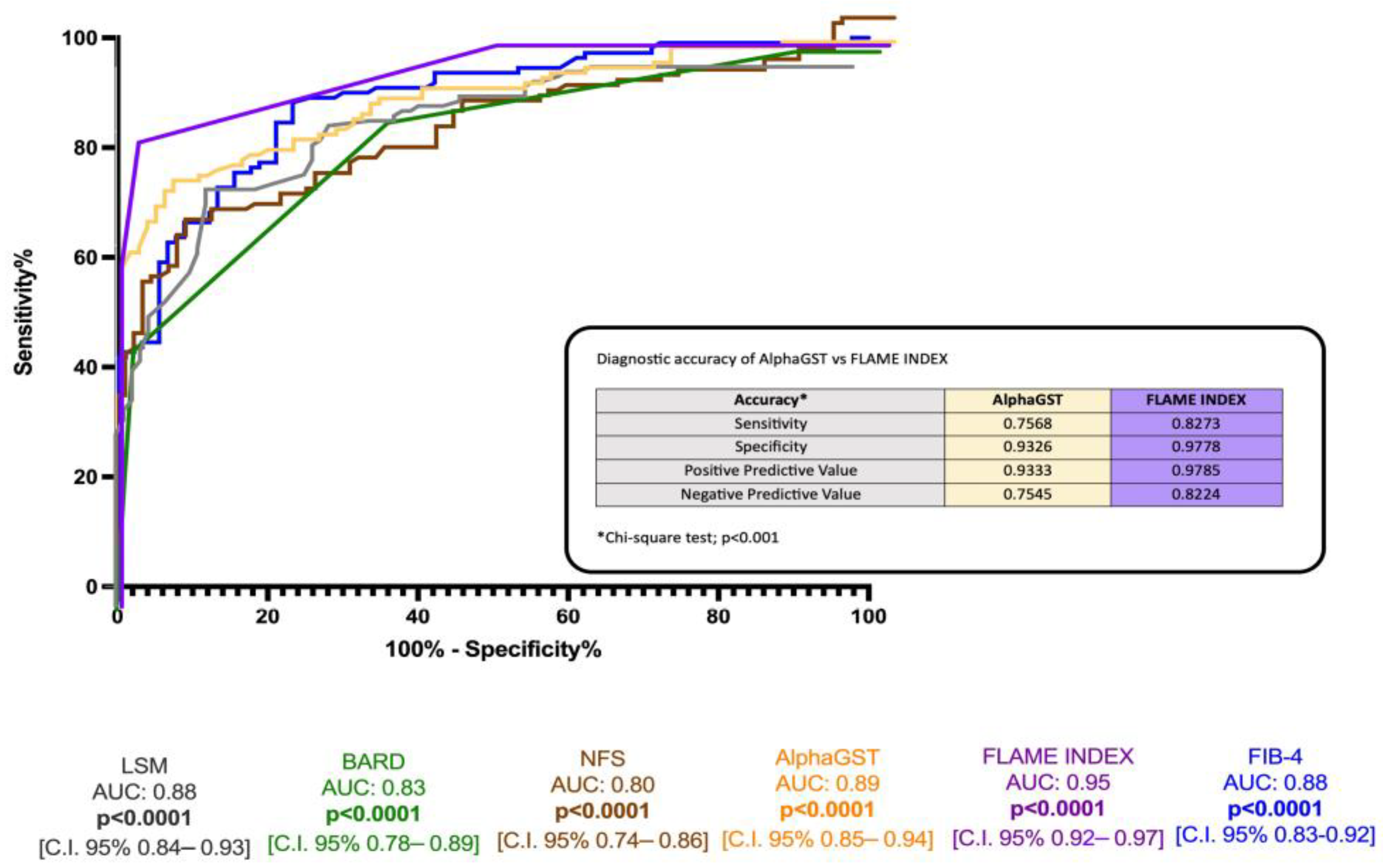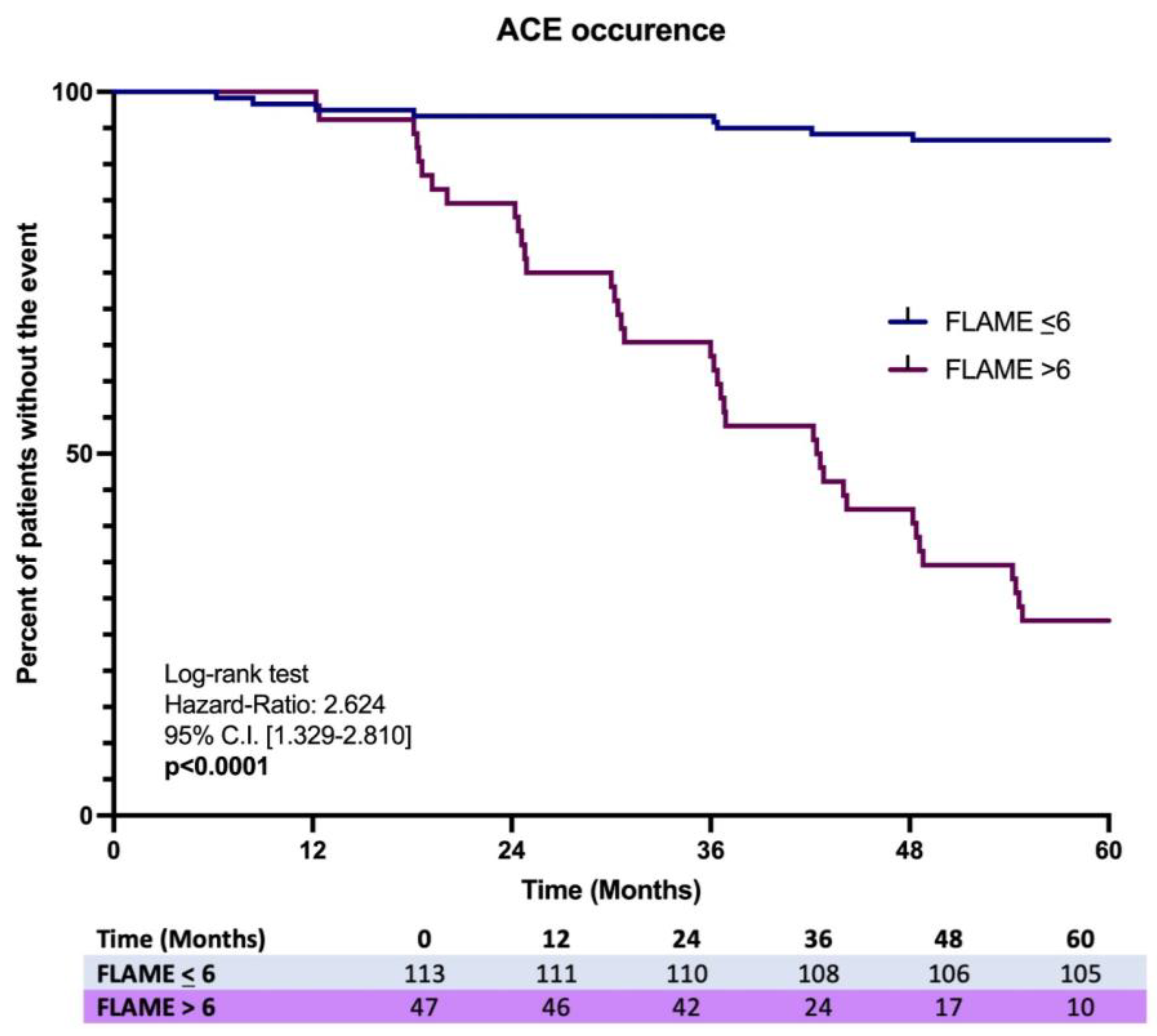FLAME: Training and Validating a Newly Conceived Model Incorporating Alpha-Glutathione-S-Transferase Serum Levels for Predicting Advanced Hepatic Fibrosis and Acute Cardiovascular Events in Metabolic Dysfunction-Associated Steatotic Liver Disease (MASLD)
Abstract
1. Introduction
2. Results
2.1. Training Cohort
2.1.1. AlphaGST and Baseline Liver Fibrosis
2.1.2. FLAME Index: Variables Selection, Composition, and Determination
2.1.3. FLAME and Baseline Liver Fibrosis
2.1.4. Acute Cardiovascular Events
2.1.5. Liver-Related Events
2.2. Validation Cohort
3. Discussion
4. Materials and Methods
4.1. Experimental Design
4.2. Patients
4.3. Anthropometrical, Clinical, and Nutritional Assessment
4.4. Biochemical Assessment
4.5. AlphaGST Levels Assessment
4.6. Abdominal US, Liver Stiffness Measurement, and Controlled Attenuation Parameter Assessment
4.7. Antropobiochemical Non-Invasive Liver Fibrosis Assessment Tools
4.8. Ultrasound-Guided Percutaneous Liver Biopsy and Histological Assessment
4.9. Statistical Analysis
5. Conclusions
Supplementary Materials
Author Contributions
Funding
Institutional Review Board Statement
Informed Consent Statement
Data Availability Statement
Acknowledgments
Conflicts of Interest
Abbreviations
References
- Hayes, P.C.; Bouchier, I.A.; Beckett, G.J. Glutathione S-Transferase in Humans in Health and Disease. Gut 1991, 32, 813–818. [Google Scholar] [CrossRef]
- Hiley, C.; Fryer, A.; Bell, J.; Hume, R.; Strange, R.C. The Human Glutathione S-Transferases. Immunohistochemical Studies of the Developmental Expression of Alpha- and Pi-Class Isoenzymes in Liver. Biochem. J. 1988, 254, 255–259. [Google Scholar] [CrossRef]
- Beckett, G.J.; Foster, G.R.; Hussey, A.J.; Oliveira, D.B.; Donovan, J.W.; Prescott, L.F.; Proudfoot, A.T. Plasma Glutathione S-Transferase and F Protein Are More Sensitive than Alanine Aminotransferase as Markers of Paracetamol (Acetaminophen)-Induced Liver Damage. Clin. Chem. 1989, 35, 2186–2189. [Google Scholar] [CrossRef]
- Loguercio, C.; Tuccillo, C.; Caporaso, N.; Del Vecchio Blanco, G.; Morisco, F.; Guerriero, C.; di Santolo, S.S.; Valenza, L.M.; Del Vecchio Blanco, C. Determination of Plasma Alpha-Glutathione S-Transferases in Patients with HCV-Related Chronic Infection: Its Significance and Possible Clinical Relevance. Liver 1998, 18, 166–172. [Google Scholar] [CrossRef] [PubMed]
- Rinella, M.E.; Lazarus, J.V.; Ratziu, V.; Francque, S.M.; Sanyal, A.J.; Kanwal, F.; Romero, D.; Abdelmalek, M.F.; Anstee, Q.M.; Arab, J.P.; et al. A Multisociety Delphi Consensus Statement on New Fatty Liver Disease Nomenclature. Hepatology 2023, 78, 1966–1986. [Google Scholar] [CrossRef] [PubMed]
- Brown, G.T.; Kleiner, D.E. Histopathology of Nonalcoholic Fatty Liver Disease and Nonalcoholic Steatohepatitis. Metabolism 2016, 65, 1080–1086. [Google Scholar] [CrossRef]
- The Lancet Gastroenterology & Hepatology. Obesity: Another Ongoing Pandemic. Lancet Gastroenterol. Hepatol. 2021, 6, 411. [Google Scholar] [CrossRef]
- Dallio, M.; Sangineto, M.; Romeo, M.; Villani, R.; Romano, A.D.; Loguercio, C.; Serviddio, G.; Federico, A. Immunity as Cornerstone of Non-Alcoholic Fatty Liver Disease: The Contribution of Oxidative Stress in the Disease Progression. Int. J. Mol. Sci. 2021, 22, 436. [Google Scholar] [CrossRef] [PubMed]
- Palma, R.; Pronio, A.; Romeo, M.; Scognamiglio, F.; Ventriglia, L.; Ormando, V.M.; Lamazza, A.; Pontone, S.; Federico, A.; Dallio, M. The Role of Insulin Resistance in Fueling NAFLD Pathogenesis: From Molecular Mechanisms to Clinical Implications. J. Clin. Med. 2022, 11, 3649. [Google Scholar] [CrossRef]
- Chung, G.E.; Heo, N.J.; Kim, D.; Kwak, M.-S.; Yim, J.Y.; Kim, J.S.; Ahmed, A. Association between Advanced Fibrosis in Fatty Liver Disease and Overall Mortality Based on Body Fat Distribution. J. Gastroenterol. Hepatol. 2020, 35, 90–96. [Google Scholar] [CrossRef]
- Castera, L.; Friedrich-Rust, M.; Loomba, R. Noninvasive Assessment of Liver Disease in Patients With Nonalcoholic Fatty Liver Disease. Gastroenterology 2019, 156, 1264–1281.e4. [Google Scholar] [CrossRef] [PubMed]
- Angelico, F.; Baratta, F.; Pastori, D.; Ben, M.D. Assessment of Hepatic Fibrosis in MAFLD: A New Player in the Evaluation of Residual Cardiovascular Risk? Dig. Liver Dis. 2021, 53, 383–384. [Google Scholar] [CrossRef] [PubMed]
- Schonmann, Y.; Yeshua, H.; Bentov, I.; Zelber-Sagi, S. Liver Fibrosis Marker Is an Independent Predictor of Cardiovascular Morbidity and Mortality in the General Population. Dig. Liver Dis. 2021, 53, 79–85. [Google Scholar] [CrossRef]
- Yanai, H.; Adachi, H.; Hakoshima, M.; Iida, S.; Katsuyama, H. Metabolic-Dysfunction-Associated Steatotic Liver Disease-Its Pathophysiology, Association with Atherosclerosis and Cardiovascular Disease, and Treatments. Int. J. Mol. Sci. 2023, 24, 15473. [Google Scholar] [CrossRef] [PubMed]
- Chan, W.-K.; Chuah, K.-H.; Rajaram, R.B.; Lim, L.-L.; Ratnasingam, J.; Vethakkan, S.R. Metabolic Dysfunction-Associated Steatotic Liver Disease (MASLD): A State-of-the-Art Review. J. Obes. Metab. Syndr. 2023, 32, 197–213. [Google Scholar] [CrossRef] [PubMed]
- Lindén, D.; Romeo, S. Therapeutic Opportunities for the Treatment of NASH with Genetically Validated Targets. J. Hepatol. 2023, 79, 1056–1064. [Google Scholar] [CrossRef] [PubMed]
- Saffo, S.; Do, A. Clinical Phenotyping and the Application of Precision Medicine in MAFLD. Clin. Liver Dis. 2022, 19, 227–233. [Google Scholar] [CrossRef] [PubMed]
- Lonardo, A.; Arab, J.P.; Arrese, M. Perspectives on Precision Medicine Approaches to NAFLD Diagnosis and Management. Adv. Ther. 2021, 38, 2130–2158. [Google Scholar] [CrossRef] [PubMed]
- Qu, W.; Ma, T.; Cai, J.; Zhang, X.; Zhang, P.; She, Z.; Wan, F.; Li, H. Liver Fibrosis and MAFLD: From Molecular Aspects to Novel Pharmacological Strategies. Front. Med. 2021, 8, 761538. [Google Scholar] [CrossRef]
- Lin, H.; Zhang, X.; Li, G.; Wong, G.L.-H.; Wong, V.W.-S. Epidemiology and Clinical Outcomes of Metabolic (Dysfunction)-Associated Fatty Liver Disease. J. Clin. Transl. Hepatol. 2021, 9, 972–982. [Google Scholar] [CrossRef]
- Liu, H.-H.; Cao, Y.-X.; Jin, J.-L.; Hua, Q.; Li, Y.-F.; Guo, Y.-L.; Zhu, C.-G.; Wu, N.-Q.; Gao, R.-L.; Li, J.-J. Liver Fibrosis Scoring Systems as Novel Tools for Predicting Cardiovascular Outcomes in Patients Following Elective Percutaneous Coronary Intervention. J. Am. Heart Assoc. 2021, 10, e018869. [Google Scholar] [CrossRef] [PubMed]
- Ajmera, V.; Loomba, R. Imaging Biomarkers of NAFLD, NASH, and Fibrosis. Mol. Metab. 2021, 50, 101167. [Google Scholar] [CrossRef]
- Agbim, U.; Asrani, S.K. Non-Invasive Assessment of Liver Fibrosis and Prognosis: An Update on Serum and Elastography Markers. Expert. Rev. Gastroenterol. Hepatol. 2019, 13, 361–374. [Google Scholar] [CrossRef] [PubMed]
- Eslam, M.; Sanyal, A.J.; George, J. International Consensus Panel MAFLD: A Consensus-Driven Proposed Nomenclature for Metabolic Associated Fatty Liver Disease. Gastroenterology 2020, 158, 1999–2014.e1. [Google Scholar] [CrossRef] [PubMed]
- Andreozzi, P.; Viscogliosi, G.; Colella, F.; Subic, M.; Cipriani, E.; Marigliano, B.; Verrusio, W.; Servello, A.; Ettorre, E.; Marigliano, V. Predictors of liver fibrosis in patients with non-alcoholic fatty liver disease. The role of metabolic syndrome, insulin-resistance and inflammation. Recenti Prog. Med. 2012, 103, 570–574. [Google Scholar] [CrossRef] [PubMed]
- Kani, H.T.; Demirtas, C.O.; Keklikkiran, C.; Ergenc, I.; Mehdiyev, S.; Akdeniz, E.; Yilmaz, Y. Evaluation of the Impact of Metabolic Syndrome on Fibrosis in Metabolic Dysfunction-Associated Fatty Liver Disease. Turk. J. Gastroenterol. 2021, 32, 661–666. [Google Scholar] [CrossRef]
- Kotani, K. The Role of Anti-Oxidative Stress in HDL. Rinsho Byori 2016, 64, 44–48. [Google Scholar] [PubMed]
- Han, G.; Ren, J.; Qin, L.; Song, J.; Wang, L.; Chen, H. High Density Lipoprotein Suppresses Lipoprotein Associated Phospholipase A2 in Human Monocytes-Derived Macrophages through Peroxisome Proliferator-Activated Receptor-γ Pathway. Chin. Med. J. 2012, 125, 4474–4480. [Google Scholar]
- Angulo, P.; Hui, J.M.; Marchesini, G.; Bugianesi, E.; George, J.; Farrell, G.C.; Enders, F.; Saksena, S.; Burt, A.D.; Bida, J.P.; et al. The NAFLD Fibrosis Score: A Noninvasive System That Identifies Liver Fibrosis in Patients with NAFLD. Hepatology 2007, 45, 846–854. [Google Scholar] [CrossRef]
- Harrison, S.A.; Oliver, D.; Arnold, H.L.; Gogia, S.; Neuschwander-Tetri, B.A. Development and Validation of a Simple NAFLD Clinical Scoring System for Identifying Patients without Advanced Disease. Gut 2008, 57, 1441–1447. [Google Scholar] [CrossRef]
- Sterling, R.K.; Lissen, E.; Clumeck, N.; Sola, R.; Correa, M.C.; Montaner, J.; Sulkowski, M.S.; Torriani, F.J.; Dieterich, D.T.; Thomas, D.L.; et al. Development of a Simple Noninvasive Index to Predict Significant Fibrosis in Patients with HIV/HCV Coinfection. Hepatology 2006, 43, 1317–1325. [Google Scholar] [CrossRef]
- Boursier, J.; Vergniol, J.; Guillet, A.; Hiriart, J.-B.; Lannes, A.; Le Bail, B.; Michalak, S.; Chermak, F.; Bertrais, S.; Foucher, J.; et al. Diagnostic Accuracy and Prognostic Significance of Blood Fibrosis Tests and Liver Stiffness Measurement by FibroScan in Non-Alcoholic Fatty Liver Disease. J. Hepatol. 2016, 65, 570–578. [Google Scholar] [CrossRef] [PubMed]
- Petta, S.; Wong, V.W.-S.; Cammà, C.; Hiriart, J.-B.; Wong, G.L.-H.; Vergniol, J.; Chan, A.W.-H.; Di Marco, V.; Merrouche, W.; Chan, H.L.-Y.; et al. Serial Combination of Non-Invasive Tools Improves the Diagnostic Accuracy of Severe Liver Fibrosis in Patients with NAFLD. Aliment. Pharmacol. Ther. 2017, 46, 617–627. [Google Scholar] [CrossRef]
- Shili-Masmoudi, S.; Wong, G.L.-H.; Hiriart, J.-B.; Liu, K.; Chermak, F.; Shu, S.S.-T.; Foucher, J.; Tse, Y.-K.; Bernard, P.-H.; Yip, T.C.-F.; et al. Liver Stiffness Measurement Predicts Long-Term Survival and Complications in Non-Alcoholic Fatty Liver Disease. Liver Int. 2020, 40, 581–589. [Google Scholar] [CrossRef] [PubMed]
- Yi, M.; Peng, W.; Teng, F.; Kong, Q.; Chen, Z. The Role of Noninvasive Scoring Systems for Predicting Cardiovascular Disease Risk in Patients with Nonalcoholic Fatty Liver Disease: A Systematic Review and Meta-Analysis. Eur. J. Gastroenterol. Hepatol. 2022, 34, 1277–1284. [Google Scholar] [CrossRef]
- Yan, Z.; Liu, Y.; Li, W.; Zhao, X.; Lin, W.; Zhang, J.; Yu, S.; Ma, J.; Wang, J.; Yu, P.; et al. Liver Fibrosis Scores and Prognosis in Patients with Cardiovascular Diseases: A Systematic Review and Meta-Analysis. Eur. J. Clin. Investig. 2022, 52, e13855. [Google Scholar] [CrossRef]
- Loosen, S.; Luedde, M.; Demir, M.; Luedde, T.; Kostev, K.; Roderburg, C. An Elevated FIB-4 Score Is Not Associated with Cardiovascular Events: A Longitudinal Analysis from 137 842 Patients with and without Chronic Liver Disease. Eur. J. Gastroenterol. Hepatol. 2022, 34, 717–723. [Google Scholar] [CrossRef] [PubMed]
- Delgado, G.E.; Kleber, M.E.; Moissl, A.P.; Yazdani, B.; Kusnik, A.; Ebert, M.P.; März, W.; Krämer, B.K.; Lammert, A.; Teufel, A. Surrogate Scores of Advanced Fibrosis in NAFLD/NASH Do Not Predict Mortality in Patients with Medium-to-High Cardiovascular Risk. Am. J. Physiol. Gastrointest. Liver Physiol. 2021, 321, G252–G261. [Google Scholar] [CrossRef] [PubMed]
- Pennisi, G.; Enea, M.; Romero-Gomez, M.; Viganò, M.; Bugianesi, E.; Wong, V.W.-S.; Fracanzani, A.L.; Sebastiani, G.; Boursier, J.; Berzigotti, A.; et al. Liver-Related and Extrahepatic Events in Patients with Non-Alcoholic Fatty Liver Disease: A Retrospective Competing Risks Analysis. Aliment. Pharmacol. Ther. 2022, 55, 604–615. [Google Scholar] [CrossRef]
- Boursier, J.; Hagström, H.; Ekstedt, M.; Moreau, C.; Bonacci, M.; Cure, S.; Ampuero, J.; Nasr, P.; Tallab, L.; Canivet, C.M.; et al. Non-Invasive Tests Accurately Stratify Patients with NAFLD Based on Their Risk of Liver-Related Events. J. Hepatol. 2022, 76, 1013–1020. [Google Scholar] [CrossRef] [PubMed]
- Villanueva, C.; Albillos, A.; Genescà, J.; Garcia-Pagan, J.C.; Calleja, J.L.; Aracil, C.; Bañares, R.; Morillas, R.M.; Poca, M.; Peñas, B.; et al. β Blockers to Prevent Decompensation of Cirrhosis in Patients with Clinically Significant Portal Hypertension (PREDESCI): A Randomised, Double-Blind, Placebo-Controlled, Multicentre Trial. Lancet 2019, 393, 1597–1608. [Google Scholar] [CrossRef]
- Mikolasevic, I.; Orlic, L.; Franjic, N.; Hauser, G.; Stimac, D.; Milic, S. Transient Elastography (FibroScan®) with Controlled Attenuation Parameter in the Assessment of Liver Steatosis and Fibrosis in Patients with Nonalcoholic Fatty Liver Disease—Where Do We Stand? World J. Gastroenterol. 2016, 22, 7236–7251. [Google Scholar] [CrossRef] [PubMed]
- Saunders, J.B.; Aasland, O.G.; Babor, T.F.; de la Fuente, J.R.; Grant, M. Development of the Alcohol Use Disorders Identification Test (AUDIT): WHO Collaborative Project on Early Detection of Persons with Harmful Alcohol Consumption—II. Addiction 1993, 88, 791–804. [Google Scholar] [CrossRef] [PubMed]
- Chuah, K.-H.; Lai, L.-L.; Vethakkan, S.R.; Nik Mustapha, N.R.; Mahadeva, S.; Chan, W.-K. Liver Stiffness Measurement in Non-Alcoholic Fatty Liver Disease: Two Is Better than One. J. Gastroenterol. Hepatol. 2020, 35, 1404–1411. [Google Scholar] [CrossRef]
- Eslam, M.; Sarin, S.K.; Wong, V.W.-S.; Fan, J.-G.; Kawaguchi, T.; Ahn, S.H.; Zheng, M.-H.; Shiha, G.; Yilmaz, Y.; Gani, R.; et al. The Asian Pacific Association for the Study of the Liver Clinical Practice Guidelines for the Diagnosis and Management of Metabolic Associated Fatty Liver Disease. Hepatol. Int. 2020, 14, 889–919. [Google Scholar] [CrossRef]
- European Association for the Study of the Liver (EASL); European Association for the Study of Diabetes (EASD); European Association for the Study of Obesity (EASO). EASL-EASD-EASO Clinical Practice Guidelines for the Management of Non-Alcoholic Fatty Liver Disease. J. Hepatol. 2016, 64, 1388–1402. [Google Scholar] [CrossRef] [PubMed]
- Poredoš, P.; Cífková, R.; Marie Maier, J.A.; Nemcsik, J.; Šabovič, M.; Jug, B.; Ježovnik, M.K.; Schernthaner, G.H.; Antignani, P.L.; Catalano, M.; et al. Preclinical Atherosclerosis and Cardiovascular Events: Do We Have a Consensus about the Role of Preclinical Atherosclerosis in the Prediction of Cardiovascular Events? Atherosclerosis 2022, 348, 25–35. [Google Scholar] [CrossRef] [PubMed]
- de Franchis, R.; Baveno VI Faculty. Expanding Consensus in Portal Hypertension: Report of the Baveno VI Consensus Workshop: Stratifying Risk and Individualizing Care for Portal Hypertension. J. Hepatol. 2015, 63, 743–752. [Google Scholar] [CrossRef]
- Andersson, C.; Nayor, M.; Tsao, C.W.; Levy, D.; Vasan, R.S. Framingham Heart Study: JACC Focus Seminar, 1/8. J. Am. Coll. Cardiol. 2021, 77, 2680–2692. [Google Scholar] [CrossRef] [PubMed]
- Bril, F.; Sanyal, A.; Cusi, K. Metabolic Syndrome and Its Association with Nonalcoholic Steatohepatitis. Clin. Liver Dis. 2023, 27, 187–210. [Google Scholar] [CrossRef] [PubMed]
- Shikany, J.M.; Safford, M.M.; Soroka, O.; Brown, T.M.; Newby, P.K.; Durant, R.W.; Judd, S.E. Mediterranean Diet Score, Dietary Patterns, and Risk of Sudden Cardiac Death in the REGARDS Study. J. Am. Heart Assoc. 2021, 10, e019158. [Google Scholar] [CrossRef] [PubMed]
- Salgado, A.L.F.d.A.; de Carvalho, L.; Oliveira, A.C.; dos Santos, V.N.; Vieira, J.G.; Parise, E.R. Insulin Resistance Index (HOMA-IR) in the Differentiation of Patients with Non-Alcoholic Fatty Liver Disease and Healthy Individuals. Arq. Gastroenterol. 2010, 47, 165–169. [Google Scholar] [CrossRef]
- Boursier, J.; Zarski, J.-P.; de Ledinghen, V.; Rousselet, M.-C.; Sturm, N.; Lebail, B.; Fouchard-Hubert, I.; Gallois, Y.; Oberti, F.; Bertrais, S.; et al. Determination of Reliability Criteria for Liver Stiffness Evaluation by Transient Elastography. Hepatology 2013, 57, 1182–1191. [Google Scholar] [CrossRef] [PubMed]
- Sasso, M.; Beaugrand, M.; de Ledinghen, V.; Douvin, C.; Marcellin, P.; Poupon, R.; Sandrin, L.; Miette, V. Controlled Attenuation Parameter (CAP): A Novel VCTETM Guided Ultrasonic Attenuation Measurement for the Evaluation of Hepatic Steatosis: Preliminary Study and Validation in a Cohort of Patients with Chronic Liver Disease from Various Causes. Ultrasound Med. Biol. 2010, 36, 1825–1835. [Google Scholar] [CrossRef] [PubMed]
- Peter, J.E.; Sasso, M.; Allison, M.; Tsochatzis, E.; Anstee, Q.M.; Sheridan, D.; Guha, I.N.; Cobbold, J.F.; Deeks, J.J.; Paradis, V.; et al. Accuracy of FibroScan Controlled Attenuation Parameter and Liver Stiffness Measurement in Assessing Steatosis and Fibrosis in Patients with Nonalcoholic Fatty Liver Disease. Gastroenterology 2019, 156, 1717–1730. [Google Scholar] [CrossRef]
- Sasso, M.; Miette, V.; Sandrin, L.; Beaugrand, M. The Controlled Attenuation Parameter (CAP): A Novel Tool for the Non-Invasive Evaluation of Steatosis Using Fibroscan. Clin. Res. Hepatol. Gastroenterol. 2012, 36, 13–20. [Google Scholar] [CrossRef] [PubMed]
- Treeprasertsuk, S.; Björnsson, E.; Enders, F.; Suwanwalaikorn, S.; Lindor, K.D. NAFLD Fibrosis Score: A Prognostic Predictor for Mortality and Liver Complications among NAFLD Patients. World J. Gastroenterol. 2013, 19, 1219–1229. [Google Scholar] [CrossRef] [PubMed]
- Kleiner, D.E.; Brunt, E.M.; Van Natta, M.; Behling, C.; Contos, M.J.; Cummings, O.W.; Ferrell, L.D.; Liu, Y.-C.; Torbenson, M.S.; Unalp-Arida, A.; et al. Design and Validation of a Histological Scoring System for Nonalcoholic Fatty Liver Disease. Hepatology 2005, 41, 1313–1321. [Google Scholar] [CrossRef]
- Ishak, K.; Baptista, A.; Bianchi, L.; Callea, F.; De Groote, J.; Gudat, F.; Denk, H.; Desmet, V.; Korb, G.; MacSween, R.N. Histological Grading and Staging of Chronic Hepatitis. J. Hepatol. 1995, 22, 696–699. [Google Scholar] [CrossRef] [PubMed]
- Bedossa, P.; Patel, K.; Castera, L. Histologic and Noninvasive Estimates of Liver Fibrosis. Clin. Liver Dis. 2015, 6, 5–8. [Google Scholar] [CrossRef]






| Demographic data | |||||
| Healthy (n:30) (A) | TrC-MASLD (n: 200) (B) | VlC-MASLD (n: 60) (C) | p-value A vs. B | p-value B vs. C | |
| Gender-Male (n and %) | 13 (43%) | 119 (59%) | 34 (56.7%) | n.s. * | n.s. * |
| Age (mean ± SD) | 49.97 ± 9.89 | 59 ± 12.52 | 59.77 ± 12.89 | n.s. ** | n.s. ** |
| Anthropometric indexes | |||||
| Variables (mean ± SD) | Healthy (A) | TrC-MASLD (B) | VlC-MASLD (C) | p-value ** A vs. B | p-value ** B vs. C |
| BMI (Kg/m2) | 24.97 ± 2.17 | 32.13 ± 2.79 | 31.37 ± 3.31 | <0.0001 | n.s. ** |
| WhR | 0.81 ± 0.05 | 1.42 ± 0.68 | 1.28 ± 0.91 | <0.0001 | n.s. ** |
| SBP (mmHg) | 115.3 ± 9.73 | 131.1 ± 12.31 | 130 ± 10.85 | <0.0001 | n.s. ** |
| DBP (mmHg) | 74.67 ± 10.42 | 87.45 ± 7.91 | 87.50 ± 8.26 | <0.0001 | n.s. ** |
| Biochemical parameters | |||||
| Variables (mean ± SD) | Healthy (A) | TrC-MASLD (B) | VlC-MASLD (C) | p-value ** A vs. B | p-value ** B vs. C |
| AST (IU/L) | 31.30 ± 10.14 | 50.86 ± 29.18 | 50.08 ± 26.26 | <0.0001 | n.s. ** |
| ALT (IU/L) | 39.37 ± 17.57 | 59.89 ± 30.36 | 59.65 ± 32.59 | <0.0001 | n.s. ** |
| GGT (IU/L) | 40.57 ± 17.99 | 74.22 ± 45.94 | 72.88 ± 47.20 | <0.0001 | n.s. ** |
| ALP (IU/L) | 92.33 ± 51.75 | 91.92 ± 22.38 | 93.89 ± 20.81 | 0.031 | n.s. ** |
| PLT (mm3) | 327.06 ± 58.92 | 236.7 ± 15.05 | 247.9 ± 13.06 | <0.0001 | n.s. ** |
| TC (mg/dL) | 135.2 ± 42.07 | 172.7 ± 46.96 | 169.2 ± 51.41 | <0.0001 | n.s. ** |
| LDL (mg/dL) | 95.93 ± 27.29 | 120.4 ± 37.19 | 120.8 ± 41.9 | 0.0002 | n.s. ** |
| HDL (mg/dL) | 44.73 ± 9.67 | 41.92 ± 9.34 | 42.07 ± 8.79 | n.s. | n.s. ** |
| TG (mg/dL) | 109.5 ± 32.14 | 141.8 ± 60.58 | 142.5 ± 54.34 | 0.003 | n.s. ** |
| FPG (mg/dL) | 100.7 ± 9.35 | 121.3 ± 16.74 | 120.2 ± 15.92 | <0.0001 | n.s. ** |
| Insulin (μU/mL) | 7.03 ± 1.62 | 12.19 ± 3.42 | 11.63 ± 3.27 | <0.0001 | n.s. ** |
| HbA1c (%) | 4.01 ± 0.42 | 5.24 ± 1.45 | 5.38 ± 1.19 | <0.0001 | n.s. ** |
| HOMA-IR | 1.77 ± 0.54 | 3.55 ± 1.25 | 3.28 ± 1.53 | <0.0001 | n.s. ** |
| TB (mg/dL) | 0.94 ± 0.17 | 1.52 ± 1.09 | 1.65 ± 1.18 | n.s. | n.s. ** |
| Albumin (g/L) | 4.42 ± 0.29 | 4.05 ± 0.52 | 3.94 ± 0.52 | <0.0001 | n.s. ** |
| PT (seconds) | 9.93 ± 7.42 | 99.94 ± 7.83 | 101.1 ± 8.85 | n.s. | n.s. ** |
| C-RP (mg/L) | 0.61 ± 0.20 | 1.63 ± 0.75 | 1.64 ± 0.34 | <0.0001 | n.s. ** |
| AlphaGST (pg/mL) | 1695 ± 191.10 | 3828 ± 236.10 | 3821 ± 239.6 | <0.0001 | n.s. ** |
| Non-invasive tools for liver disease severity assessment | |||||
| Variables (mean ± SD) | Healthy (A) | TrC-MASLD (B) | VlC-MASLD (C) | p-value ** A vs. B | p-value ** B vs. C |
| LSM (kPa) | / | 9.67 ± 4.91 | 10.34 ± 4.68 | / | n.s. ** |
| CAP (dB/m) | / | 271.3 ± 11.69 | 270.2 ± 11.97 | / | n.s. ** |
| NFS | / | −0.89 ± 2.04 | −0.87 ± 1.98 | / | n.s. ** |
| FIB-4 | / | 2.24 ± 1.72 | 2.32 ± 1.83 | / | n.s. ** |
| BARD | / | 2.17 ± 1.15 | 2.21 ± 1.16 | / | n.s. ** |
| Nutritional Habits | |||||
| Healthy (n:30) (A) | TrC-MASLD (n:200) (B) | VlC-MASLD (n: 60) (C) | p-value A vs. B | p-value B vs. C | |
| MedDiet (n and %) | 12 (40%) | 91 (45.5%) | 26 (43.3%) | n.s. * | n.s. * |
| Active exercise (n and %) | 13 (43.3%) | 88 (44%) | 28 (46.6%) | n.s. * | n.s. * |
| Domain | Variable | Threshold | Points | |
| A | Free plasma glucose/insulin resistance-related abnormalities | HbA1c (%) | ≤5.5 | 1 |
| >5.5 | 2 | |||
| B | Lipid- Associated Metabolic alterations | HDL (mg/dL) | HDL > 43.5 | 1 |
| HDL ≥ 43.5 | 2 | |||
| C | Excretion of liver-injuring toxic metabolites/anti-oxidative stress mechanisms—impairment | AlphaGST (pg/mL) | ≤3917 | 2 |
| >3917 | 4 | |||
| FLAME TOTAL SCORE (min–max) | MIN: 4-MAX: 8 | |||
Disclaimer/Publisher’s Note: The statements, opinions and data contained in all publications are solely those of the individual author(s) and contributor(s) and not of MDPI and/or the editor(s). MDPI and/or the editor(s) disclaim responsibility for any injury to people or property resulting from any ideas, methods, instructions or products referred to in the content. |
© 2025 by the authors. Licensee MDPI, Basel, Switzerland. This article is an open access article distributed under the terms and conditions of the Creative Commons Attribution (CC BY) license (https://creativecommons.org/licenses/by/4.0/).
Share and Cite
Dallio, M.; Romeo, M.; Di Nardo, F.; Vaia, P.; Napolitano, C.; Ventriglia, L.; Coppola, A.; Silvestrin, A.; Olivieri, S.; Federico, A. FLAME: Training and Validating a Newly Conceived Model Incorporating Alpha-Glutathione-S-Transferase Serum Levels for Predicting Advanced Hepatic Fibrosis and Acute Cardiovascular Events in Metabolic Dysfunction-Associated Steatotic Liver Disease (MASLD). Int. J. Mol. Sci. 2025, 26, 761. https://doi.org/10.3390/ijms26020761
Dallio M, Romeo M, Di Nardo F, Vaia P, Napolitano C, Ventriglia L, Coppola A, Silvestrin A, Olivieri S, Federico A. FLAME: Training and Validating a Newly Conceived Model Incorporating Alpha-Glutathione-S-Transferase Serum Levels for Predicting Advanced Hepatic Fibrosis and Acute Cardiovascular Events in Metabolic Dysfunction-Associated Steatotic Liver Disease (MASLD). International Journal of Molecular Sciences. 2025; 26(2):761. https://doi.org/10.3390/ijms26020761
Chicago/Turabian StyleDallio, Marcello, Mario Romeo, Fiammetta Di Nardo, Paolo Vaia, Carmine Napolitano, Lorenzo Ventriglia, Annachiara Coppola, Alessia Silvestrin, Simone Olivieri, and Alessandro Federico. 2025. "FLAME: Training and Validating a Newly Conceived Model Incorporating Alpha-Glutathione-S-Transferase Serum Levels for Predicting Advanced Hepatic Fibrosis and Acute Cardiovascular Events in Metabolic Dysfunction-Associated Steatotic Liver Disease (MASLD)" International Journal of Molecular Sciences 26, no. 2: 761. https://doi.org/10.3390/ijms26020761
APA StyleDallio, M., Romeo, M., Di Nardo, F., Vaia, P., Napolitano, C., Ventriglia, L., Coppola, A., Silvestrin, A., Olivieri, S., & Federico, A. (2025). FLAME: Training and Validating a Newly Conceived Model Incorporating Alpha-Glutathione-S-Transferase Serum Levels for Predicting Advanced Hepatic Fibrosis and Acute Cardiovascular Events in Metabolic Dysfunction-Associated Steatotic Liver Disease (MASLD). International Journal of Molecular Sciences, 26(2), 761. https://doi.org/10.3390/ijms26020761








